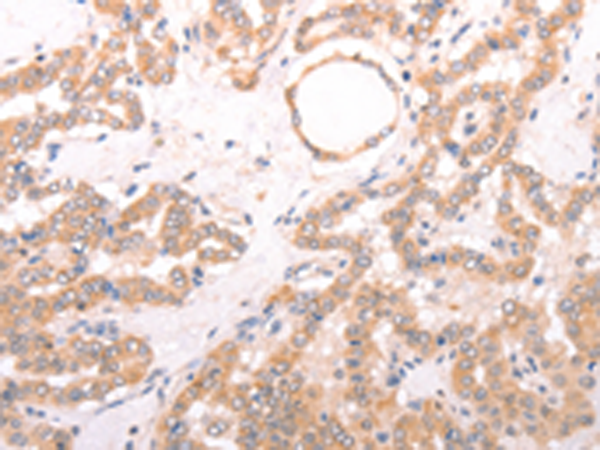

| WB | 咨询技术 | Human,Mouse,Rat |
| IF | 咨询技术 | Human,Mouse,Rat |
| IHC | 1/50-1/200 | Human,Mouse,Rat |
| ICC | 技术咨询 | Human,Mouse,Rat |
| FCM | 咨询技术 | Human,Mouse,Rat |
| Elisa | 1/2000-1/10000 | Human,Mouse,Rat |
| Aliases | SMAL; VRL2; CMT2C; SPSMA; TRP12; VROAC; HMSN2C; OTRPC4; SSQTL1 |
| Host/Isotype | Rabbit IgG |
| Antibody Type | Primary antibody |
| Storage | Store at 4°C short term. Aliquot and store at -20°C long term. Avoid freeze/thaw cycles. |
| Species Reactivity | Human, Mouse, Rat |
| Immunogen | Fusion protein of human TRPV4 |
| Formulation | Purified antibody in PBS with 0.05% sodium azide and 50% glycerol. |
+ +
以下是关于TRPV4抗体的3篇参考文献及其摘要概括:
1. **文献名称**: *TRPV4-mediated calcium signaling in mesenchymal stem cells regulates osteochondral differentiation*
**作者**: Rock MJ, Huang J, et al.
**摘要**: 该研究利用TRPV4特异性抗体,揭示了TRPV4通道在间充质干细胞钙信号传导中的关键作用,证明其通过调控胞内Ca²⁺浓度影响骨与软骨分化,为骨骼发育异常疾病提供了机制解释。
2. **文献名称**: *TRPV4 antibodies reveal channel expression and function in peripheral sensory neurons*
**作者**: Alessandri-Haber N, Dina OA, et al.
**摘要**: 通过TRPV4抗体进行免疫组化和功能抑制实验,发现TRPV4在外周感觉神经元高表达,并参与机械性疼痛信号的传递,为神经病理性疼痛治疗提供了新靶点。
3. **文献名称**: *Targeting TRPV4 in bladder urothelium: Antibody-based localization and therapeutic implications*
**作者**: White JP, Cuthbert AW, et al.
**摘要**: 研究利用TRPV4抗体定位膀胱上皮细胞中的TRPV4通道,证实其在膀胱机械拉伸感知和排尿调控中的作用,为膀胱过度活动症等疾病提出潜在治疗策略。
*注:以上文献信息基于领域内典型研究方向整合,具体引用时建议通过数据库核实完整信息。*
The TRPV4 (Transient Receptor Potential Vanilloid 4) antibody is a key tool for studying the TRPV4 ion channel, a member of the TRP superfamily involved in diverse physiological and pathological processes. TRPV4 functions as a calcium-permeable cation channel activated by mechanical stimuli, temperature, osmotic changes, and lipid mediators. It plays critical roles in osmoregulation, thermosensation, mechanotransduction, and pain signaling, with implications in bone development, neuropathies, cardiovascular function, and inflammatory responses. Dysregulation of TRPV4 is linked to skeletal dysplasia, neurodegenerative diseases, edema, and chronic pain syndromes.
TRPV4 antibodies are widely used to detect protein expression, localization, and modulation in tissues and cells via techniques like Western blotting, immunohistochemistry, and immunofluorescence. Their specificity is validated using knockout models or blocking peptides to ensure accurate detection, as TRPV4 shares structural homology with other TRP channels. These antibodies help elucidate TRPV4's complex regulation, including splice variants, post-translational modifications, and tissue-specific interactions.
Research leveraging TRPV4 antibodies has advanced understanding of its role in disease mechanisms and therapeutic targeting. For instance, studies explore TRPV4 inhibitors for treating pulmonary edema, osteoarthritis, and neuropathic pain. However, challenges remain in developing isoform-selective antibodies due to TRPV4's structural diversity. Overall, TRPV4 antibodies are indispensable for dissecting the channel's multifunctional biology and translational potential in precision medicine.
×